- info@wildlife-removal.com
Call us for help in your town
Wildlife Removal Education
How to Get Squirrels Out of the Attic
Need squirrel removal in your hometown? We service over 500 USA locations! Click here to hire us in your town and check prices - updated for year 2020.
One of the most common jobs that I deal with as a nuisance wildlife control professional is a case of squirrels in the attic. It is not an easy thing to take care of!
The problem is that there are almost always baby squirrels in the attic, along with an adult female. The young are helpless in a nesting area of the attic for the first 6 weeks of life, and can't be trapped. They
must be removed by hand - you or the wildlife technician you hire must go into the attic and remove the babies by hand. If you wait longer than 6 weeks after birth, then the young are almost adult sized, and
run all around just like the mother squirrel, in which case they can be trapped and removed or excluded all the same way. In the below photo you see some 1-week old squirrels in an attic nest, and then some 7-week
old squirrels. They grow quickly!
We now service over 500 locations! Click here to hire us for wildlife removal in your town.

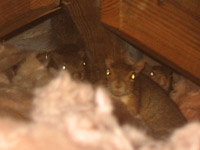
Many people who want to know how to get squirrels out of the attic believe that they must set squirrel traps in the attic, as seen below. I took the below photo many years ago, back when I didn't know what I was doing.
The truth is that it's very hard to trap squirrels in the attic, and they almost NEVER enter cage traps inside the attic. I just got lucky in this case. Most of the time, my traps in the attic caught nothing. Plus,
attic trapping is dangerous, because it's hard to check the traps, and the last thing you want is an animal suffering in a trap for a long time. Please read: squirrel trapping guide.
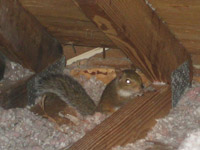
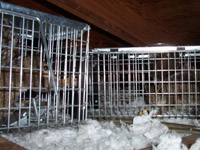
Now the below case is more like it. See, if you want to know how to get rid of squirrels in your house, you have to find out how they are getting inside the house in the first place! It might be something like a flimsy
soffit screen, as seen below. Wherever it is, it's easy to mount a special repeater trap right on the hole, and catch the target squirrels as they vacate the house - which they do several times each day - for food and water.
You can also set a one-way exclusion door to let them get out, but not back in. Just be sure that the home is squirrel-proof, and that there's no other place to get in, or you'll be asking me how to get squirrels out
of the ceiling yet again. Read more about the one way door.
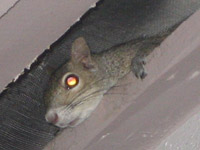
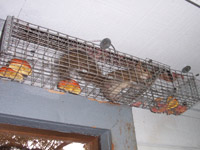
You may want to read about How much does it cost to remove squirrels in the attic, but the price varies. Your best bet is to
Click here for a squirrel removal price quote in your city or town.
Once all the squirrels are out, you want to seal the entry point(s) shut permanently. If you don't, new animals will move into your attic soon. All repairs should be made with steel, so that rodents can't gnaw their way back in. The squirrels living there gave it an
odor that might attract new wildlife quickly. There's also the matter of the mess the squirrels have left behind in the attic, which often must be cleaned up.
And please remember, you often do not have to trap the squirrels in cages at all. Eviction is one of the best means of getting rid of squirrels in the attic. If you perform all the building or house repairs FIRST, and
make sure there are no other entry points for the animals to get inside, you can then mount a one-way exclusion door on the primary squirrel entry/exit hole. This allows the squirrels to get out, as they naturally do
several times each day for food and water, but then not get back in. But WARNING: do not do this if you have just one active female squirrel, because she almost certainly has a nest of baby squirrels in the attic, too
small and young to go out the one-way door. You must wait a few weeks, about 6 after birth, for them to be nearly adult-sized and up and active, and able to go out the door. Otherwise, they will be stuck inside, the
mother will frantically chew your house to get back inside, and if she can't the young will starve to death.
Four Stepts for How To Get Rid Of Eastern Gray Squirrels In Your Attic -
You know that you have at least one squirrel living in your attic. You can hear it rummaging around and you can smell the odor of animal urine as well. You need to get rid of it before it causes extensive damage.
If you hear only one squirrel, it's probably a female, and she may have a litter of young. You need to remove these by hand, or wait a few weeks until you hear the young running about. Then you can:
STEP 1 - Make sure all the holes leading into the house are sealed shut - check all roof vents, dormers, soffits, etc. But leave the main hole (it's usually obvious, big, with chewing around it) open.
STEP 2 - Either trap all the squirrels using roof-mounted cage traps, or mount repeater traps or one-way exclusion doors on the primary entry/exit hole.
STEP 3 - Once they're all out, trapped and relocated, seal up the final entry hole, with steel, so no new squirrels can chew in again.
STEP 4 - Clean up the attic, with a special antimicrobial fogging agent.
This directory covers every US city and town. Here are some examples of
cities serviced:
Phoenix Squirrel Control -
Los Angeles Squirrel Control -
San Diego Squirrel Control -
San Jose Squirrel Control -
Denver Squirrel Control -
Orlando Squirrel Control -
Miami Squirrel Control -
Jacksonville Squirrel Control -
Atlanta Squirrel Control -
Chicago Squirrel Control -
Baltimore Squirrel Control -
Boston Squirrel Control -
Minneapolis Squirrel Control -
Charlotte Squirrel Control -
Portland Squirrel Control -
Philadelphia Squirrel Control -
Houston Squirrel Control -
Seattle Squirrel Control -
Rochester Squirrel Control
AN EMAIL SENT TO ME:
Hi,
We've had that squirrel in our attic (not properly attic, it's the roof of our carport - Editor's note: read How to Get Squirrels Out of Your Roof) for about 3 weeks. I wanted to frighten her away, but my wife kept saying that she was sure she was pregnant, and let's just not bother her. But I really wanted to get rid of her because
of her chewing on the woods. So tonight, after reading your site, I decided the best option would certainly be to remove the nest and hoping that without nest she would go build another one elsewhere. So I climbed on my ladder and opened the roof (I could easily reach
the nest by lifting one of the metallic sheaths bordering the roof) and proceeded to dump her nest into a lawn refuse bag, with her watching me saying nothing. And suddenly I hear squeaking from inside the bag. My heart made a bump and my legs softened as I went to the
car for the torchlight to see what I was doing. I started to empty the refuse bag into a smaller cardboard box, little by little, and I saw a tiny little pink thing moving her front legs and squeaking. My legs softened still more, but somehow I climbed back on the ladder
and pushed the little baby squirrel rather vigorously into what remained of her nest, or at least close by. I got down and continued checking the contents of my bag and I found three more babies whom I put again like their brother (without much care) into what remained of
the nest. Then, not hearing any more squeaking and not seeing any more pinky babies, I proceeded to put her nest back into the attic (not at the original location close to the top of the roof, I was afraid to do so and hurting the babies, but close to the bottom of the roof,
where her entrance to the roof is and it was easier to deliver the ruins of her nest), thinking that maybe, in the dark, she will be able to find and drag her four babies back into the original nest and then use the branches I just gave her back to rebuild her nest. Now I can
hear her working, and some squaking, I think they've moved the entire family to the bottom of the roof where I put the nest back.
Now, of course, after seeing these tiny defenseless creatures, I feel bad and hope they're all right and nothing will happen to them and they will grow healthy and live happy ever after. I hope the trauma is not too big, I hope I didn't hurt anybody, and I hope the mother will be able to take good care of her family. My wife now is just laying peanuts by the entrance of the roof.
Now I guess that what we'll do is hope that when they grow older, they leave this place and then we'll shut all the entrances. That's not the best roof, but that's the roof we have.
Thanks for your website that taught me that four babies is pretty much what to expect, and that reminded me to try to treat creatures in a humane way. Maybe without reading you I would have just drowned the poor babies hoping that the mother would die of sadness. Do you have an idea what I should expect now, given what they endured, with respect to the welfare of their family? Please answer.
Thanks, and with best regards,
Francois
MY RESPONSE:
Francois - Wow! You're really nice and humane! That's rare. It's also rare for someone to find and remove a squirrel nest with babies. Kudos! You could have, if you wanted to, kept the babies out and given them to a wildlife rehabber and sealed the garage ceiling shut to keep
her out permanently. But if you want what's best for the welfare of the squirrels and are okay with having them live in the ceiling, just let them be for about 7 more weeks, then they will be old enough to survive outside of the ceiling. You can set a one-way exclusion door on the
entry hole and let them all get out, then seal the hole(s) permanently so that no more get inside in the future. - David
HOW TO GET RID OF SQUIRRELS IN THE ATTIC - THE BOTTOM LINE
The point here is that it's often a very difficult job to get squirrels out of your attic and there's many considerations. If you want to know
how to get squirrels out of your house, any part of it, from the ceiling to the walls, you should know that you want to hire a competent company who can demonstrate true wildlife knowledge, and promise to go in the attic or cut open the walls to get out the
baby squirrels. That's the only way it can be done, unless you want to wait until the young grow older by 6-7 weeks. Another important step in the how to get squirrels out of the ceiling or walls process is to find out how they get into the house in the first place,
and seal those entry points shut permanently, as stated. That's how you get rid of squirrels in the attic!
Can you use a repellent to get squirrels out of the attic?
Unfortunately no. Some people think you can, and one such person wrote me this advice, via email: take a couple of bottles of ammonia with you and at least four, flat pans,
preferably plastic ones. Close the attic door behind you tightly to leave no gap where squirrels could escape
into the house. Wear a face mask for this because of the smells of ammonia and dust from squirrel excrement. Place the pans into the corners of the attic. Fill them perhaps three quarters with ammonia. Wear rubber
gloves to protect your hands because next you soak large rags in ammonia. Wipe them along the attic where floor meets wall; except at their exit hole. You don’t want to block the exit with ammonia smell. Leave several
ammonia soaked rags around the perimeter of the attic floor. Repeat this weekly until they are gone. Once they have left, begin repairs so they can’t re-enter.
I asked this person if they'd tried this themselves, and they said no, that they read it. The truth is that I've been to many houses in which people have put mothballs in the attic, ammonia, coyote urine, sound machines,
and none of them help at all, because a squirrel's survival instinct is so strong that it won't leave the attic just because of a scent. Squirrels usually always live near the edge of the attic anyway, near the well-ventilated
soffit, and the odors just don't help.
Different Ways to Get Squirrels Out of the Attic
There are actually a number of methods that you could turn to when it comes to removing squirrels from your attic, but not all of them are going to be effective, cost-effective, or worth your while.
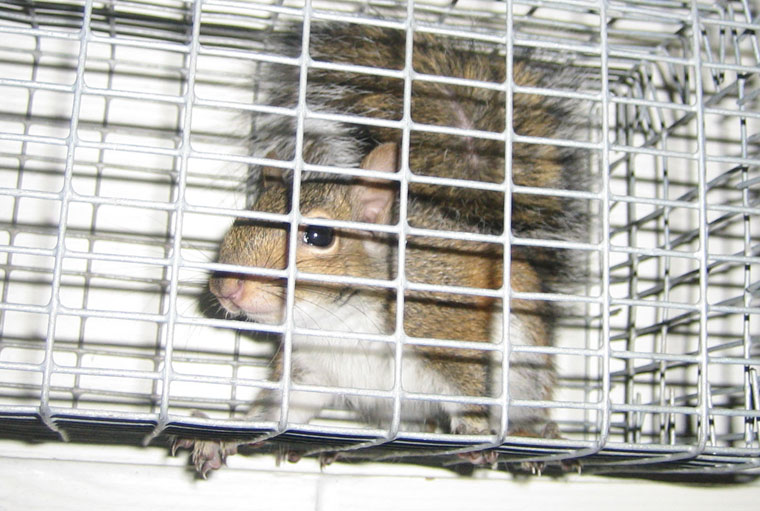
Some methods don't work at all, or are just not that well suited to the squirrel. Some methods are dangerous to other animals and potentially even yourself. Other methods might leave you with even bigger problems on your hands.
You want the truth, right?
Squirrel Repellents
Let's get this one out of the way nice and early — squirrel repellents and deterrents very rarely work. They don't work to evict an animal that has already moved in — you will need to make sure your home or building is sealed for that. Without appropriate sealing, you are letting not only squirrels get in again, but other wild animals too.
Ammonia is toxic and deadly to all wild animals, not just squirrels, so should definitely be avoided. The same can be said for mothballs — they’re actually much more harmful to the environment than you might think, for something that has been used and “sworn by” for years.
Liquid and granule-based squirrel repellents usually rely on a bad taste or smell to keep the critter away, and they don't seem to mind too much about bad smells. Otherwise, they wouldn’t be hanging around in your garbage can and they’re definitely doing that. These repellents also need to be reapplied regularly, otherwise their effectiveness decreases. A good rainy spell might wash any potentially effective repellent away. Long term use of repellents has also shown to be the least effective squirrel removal solution. Even electrical options need to be run on something ... batteries? Mains operated? Solar-powered is best, but these often come with much higher initial purchasing costs.
If you are going to use any squirrel repellent at all, use raccoon eviction fluid, also referred to as wildlife eviction fluid. This mimics the scent of predators and might just encourage the squirrel to leave of its own accord, letting you then free to seal your home or building.
Squirrel Trapping
Squirrel trapping can actually work, provided you have the right traps, put them in exactly the right places, put just the right bait in them, have the traps in the first place, know where to release a trap afterwards, and also know and understand the legal implications of everything you’re doing.
Most states class squirrels as game animals, and that requires you to have the appropriate trapping permits or licenses for game animals. It also means that you can usually only kill or trap squirrels during open season, which will not be all year round.
Some squirrels are protected in certain states, especially if they are the official animal of that state. Make sure that you do your own research into the trapping of squirrels in your area.
Almost all animals, including squirrels, will die when they are trapped and then released back into the wild. That’s presuming you have driven the animal far enough away so that it can’t make it’s way back home again.
Squirrel Poisoning
Well, if we’re going by the good, the bad, and the ugly, poisoning a squirrel would definitely fall into the ugly category. It’s one of the worst things you can do, and not only puts the lives of every other animal in that particular area at risk, it also won't do the job.
There is no registered poison for squirrels, which means that you would either need to come up with a DIY recipe, or use something else, such as rodenticide, in larger amounts. The more poison you use, the more dangerous it is. Are there kids in your neighborhood? You might want to rethink using poison. How about pets? Again, you may wish to reconsider. Oh, and once more — make sure you check the legalities surrounding killing squirrels in your local area.
Squirrel Exclusion
Exclusion devices can actually work very well when they are used properly. You can create your own DIY squirrel exclusion device, but they're easily bought commercially too. They look very similar to a regular live cage trap for squirrels, but it doesn't lock the creature inside the contraception. It is free to leave the trap, but once the door has closed, it is unable to get back in. It doesn't know that though, of course.
Exclusion devices are NOT suitable for female squirrels with a nest of young, unless they are old enough to leave the nest too. Otherwise, you’ll just have a nest full of baby squirrels on the inside which will die if the mother squirrel on the outside can’t get back in.
Squirrel Sealing
In reality, it doesn’t matter what approach you take to squirrel removal if you don't seal up the building properly. One animal will always attract another — that's the way of the world. One squirrel might leave, but another will soon jump in that spot, or another animal — a rat, perhaps? Or a raccoon?
Once you have gotten the squirrel(s) out of your building, you must do everything that you can to keep it out. This will involve properly sealing up your home and protecting it to ensure other squirrels or wild critters can’t get back in, alongside making modifications to your actual property — front and back yard — to ensure that you aren't attracting the animals by mistake. Food is usually the biggest attractant, but you might be surprised to learn that it is not the only one.
Go back to the Squirrel Removal page, or learn tips to do it yourself with my How to Get Rid of Squirrels guide.


















